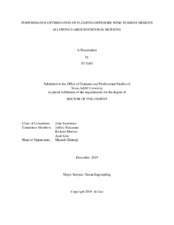| dc.contributor.advisor | Sweetman, John | |
| dc.creator | Gao, Ju | |
| dc.date.accessioned | 2020-09-10T14:18:54Z | |
| dc.date.available | 2021-12-01T08:43:21Z | |
| dc.date.created | 2019-12 | |
| dc.date.issued | 2019-11-15 | |
| dc.date.submitted | December 2019 | |
| dc.identifier.uri | https://hdl.handle.net/1969.1/189037 | |
| dc.description.abstract | A newly evolving concept in utility-scale floating wind turbines is investigated through design optimization. The ideal hull length is selected from seven new designs, based on optimizing the trade-off between minimizing structural weight and maximizing electricity harvest. The seven new spar-buoy designs have drafts ranging from 62 to 120 m. Each floater hull has been developed in conformance with industry-standard structural guide API Bulletin 2U. Performance is assessed with the Loose software using time-domain analysis and irregular winds and waves. The simulation method is based on multi-body theory in Euler-space, which does not rely on small-angle assumptions. Nonlinear hydrostatic restoring forces and moments are derived for large rotational angles in the pitch-roll-yaw Euler angle sequence. Environmental forcing by wind is computed using aero-elastic theory. A new individual pitch control (IPC) method based on DISCON control routine is investigated as a possible means to improve generating efficiency. The pitch angle of each blade is individually controlled relative to a mean angle computed by DISCON to maintain the ideal angle of attack by removing the angle change caused by inclining tower. A comparison of the generating efficiency between IPC and traditional collective pitch control shows that IPC is not an effective way to increase output power.
A new analytical far wake model for yawed or tilted wind turbines is developed based on the Joukowski transformation and conservation of momentum and mass. The wake cross section at any downstream distance is divided into a series of annular rings, inside which conservation of momentum is applied. The wake of a yawed or tilted wind turbine evolves into a kidney or oval shape, depending on the incoming wind speed and the angle of yaw or tilt. The Joukowski transformation is used to predict both kidney-shaped and oval far wakes. The analytical model is calibrated using numerical simulations computed for different angles of tilt and different wind speeds using a large eddy computational fluid dynamic model. The new wake model is easy to use and requires only minimal computational expense to predict the wake expansion shape and the varying velocity within the wake field. Comparison between the new wake model and numerical simulation results demonstrates that the newly developed wake model effectively predicts both the wake boundaries and the wake velocity deficit. Fatigue damage is assessed for blades of floating offshore wind turbines operating on three different hull configurations using two different strain-based methods. The hull configurations are selected to cover a wide range of rotational stiffness. Nonlinear beam theory is applied to compute the 3-D beam displacements along the turbine blades. Time histories of the same beam displacements are converted to maximum principal strains and to normal strains, and then the maximum principal strain method, one of the commonly used multiaxial fatigue analysis methods, and the normal strain method are used to compute the fatigue damage of the blade shell, respectively. Results show that the two methods yield meaningfully different predictions of fatigue lives and locations of fatigue failures. The normal strain method significantly underpredicts fatigue damage compared with the maximum principal strain method. Blade fatigue on floaters with very low rotational stiffness is found to be worse than on those with moderate rotational stiffness. Performance of downstream FOWT’s in the wakes of upstream turbines is assessed including electricity harvest and structural resonant responses. Results demonstrate that wakes have significant impact on power generation of downstream turbines and can excite resonant responses of platforms. | en |
| dc.format.mimetype | application/pdf | |
| dc.language.iso | en | |
| dc.subject | Floating offshore wind turbine | en |
| dc.subject | spar-type floater | en |
| dc.subject | compliant floaters | en |
| dc.subject | far wake model | en |
| dc.subject | kidney-shaped wakes | en |
| dc.subject | multiaxial fatigue analysis | en |
| dc.subject | | en |
| dc.title | Performance Optimization of Floating Offshore Wind Turbine Designs Allowing Large Rotational Motions | en |
| dc.type | Thesis | en |
| thesis.degree.department | Ocean Engineering | en |
| thesis.degree.discipline | Ocean Engineering | en |
| thesis.degree.grantor | Texas A&M University | en |
| thesis.degree.name | Doctor of Philosophy | en |
| thesis.degree.level | Doctoral | en |
| dc.contributor.committeeMember | Falzarano, Jeffery | |
| dc.contributor.committeeMember | Mercier, Richard | |
| dc.contributor.committeeMember | Anis, Ayal | |
| dc.type.material | text | en |
| dc.date.updated | 2020-09-10T14:18:55Z | |
| local.embargo.terms | 2021-12-01 | |
| local.etdauthor.orcid | 0000-0002-4474-9430 | |


